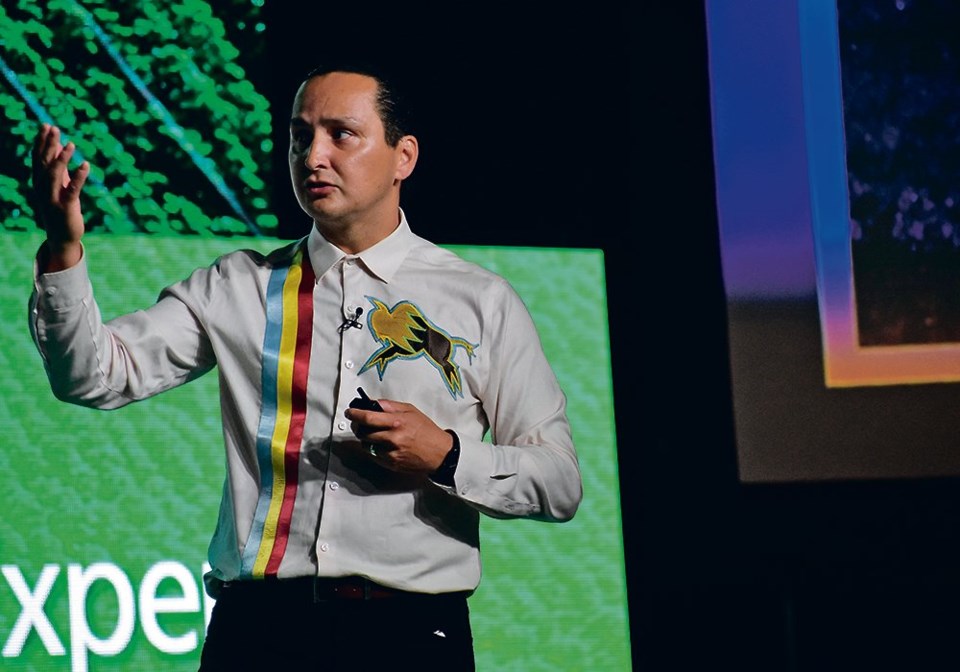REGINA — A First Nation in Saskatchewan is working toward farming its own land, but its chief says the obstacles can be daunting

Last week’s event in Regina previously known as Canada’s Farm Progress Show began by discussing progress in Indigenous agriculture.
Cowessess First Nation Chief Cadmus Delorme spoke at what’s now Canada’s Farm Show about reconciliation through the advancement of agriculture and how Indigenous communities haven’t been given fair opportunity in the past for economic inclusion.
“I wanted to make sure I captured the reality that we’re farmers without any race, without any skin colour. We’re farmers,” Delorme said after his speech.
He was elected as chief six years ago and started 4-C Farms Inc. one year later. Cowessess now farms 5,000 acres of grain and has approximately 150 cattle and Delorme hopes it will one day farm 20,000 acres.
“I love it,” said Delorme, “I grew up in my community. The field right in front of my house, I live where my parents raised me. I live there now and raise my kids. We farm that field.
“As a kid I watched a non-Indigenous farmer, a very nice man, farm it. Now today I tell my kids ‘we farm this,’ and it’s just an uplifting feeling.”
When elected, Delorme raised the land rent to what he considered fair market value and used the extra income to begin 4-C Farms and jumpstart the economic growth that Cowessess has seen under his leadership.
For Indigenous farmers, this is no easy task. First Nation reserves have agricultural land under status title, but Delorme says they struggle to get permission from government to access and use the land as they desire because of the Indian Act.
“Land is an asset in farming (but) to Indigenous people, it’s become a liability in regards to the way that it’s viewed … People coming in to help must understand the land is a challenge to use as an equity.”
In his speech, Delorme said Cowessess still leases 85 per cent of its land to non-Indigenous people. Five years ago, it leased all of it.
Between the Bank Act of Canada and the Indian Act, he says it is nearly impossible to get loans and financing for agricultural purposes, so equipment and other necessary farm expenses are purchased from farm profits.
“The Indian Act, it’s against economic growth,” said Delorme. “It’s the main federal legislation that hinders farming.”
The Indigenous Agriculture Initiative is a federal grant designed to help bridge the gap between Indigenous and non-indigenous farmers. Cowessess has received funds in the past through that initiative but there was another challenge.
“Indigenous people require capacity training,” Delorme said.
As the government enforced the Indian Act and sent Indigenous children to residential schools, Cowessess and other First Nations found they could not succeed in agriculture within the regulations set out for them, he said.
4-C Farms has both Indigenous and non-Indigenous employees, with some non-Indigenous employees in mentorship and training roles. Delorme stressed the importance of all people coming together to make this happen.
“It’s amazing,” he said, “I go to Cowessess 4-C Farms and there’s non-Indigenous people there. I go up, shake their hand and I thank them. At the same time, they must be bought in to what the vision is.
“I constantly tell them, ‘one day we’re going to work you out of a job here. Do you have an issue with that?’ They say ‘no, that’s why I am here, I’m here to help.’ One day, hopefully a Cowessess person takes over.”
Delorme has put emphasis on teaching the next generation about agriculture and the next generation of all people about the past.
“Sometimes the parents and grandparents weren’t taught the truth. … Sometimes that ignorance might continue. It’s up to us to put our shields down and learn more.”
One of the first steps is to get more Indigenous voices and decision makers involved, he added.
“The federal government and provincial government have to include more Indigenous conversation at the (strategy) planning meetings the next 10 years,” said Delorme.
“That’s not happening right now. And so that is the next big stage, is to make sure when you’re talking agriculture, check your table. If there’s no Indigenous people there, you have to reach out.”



